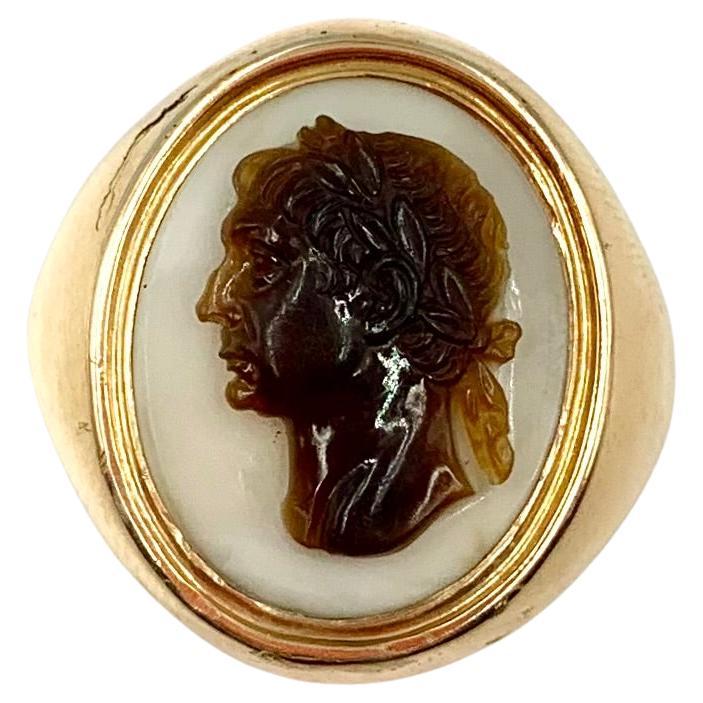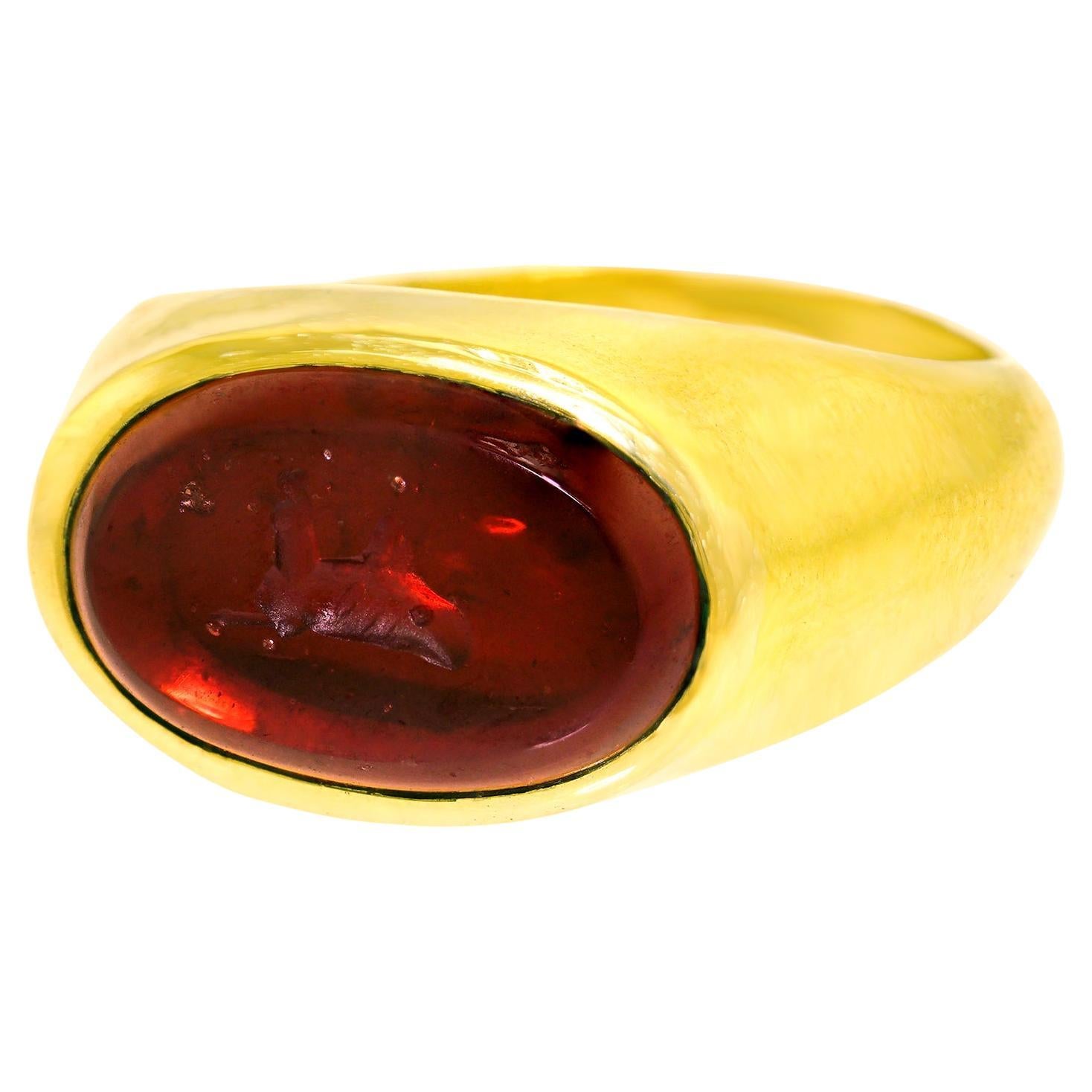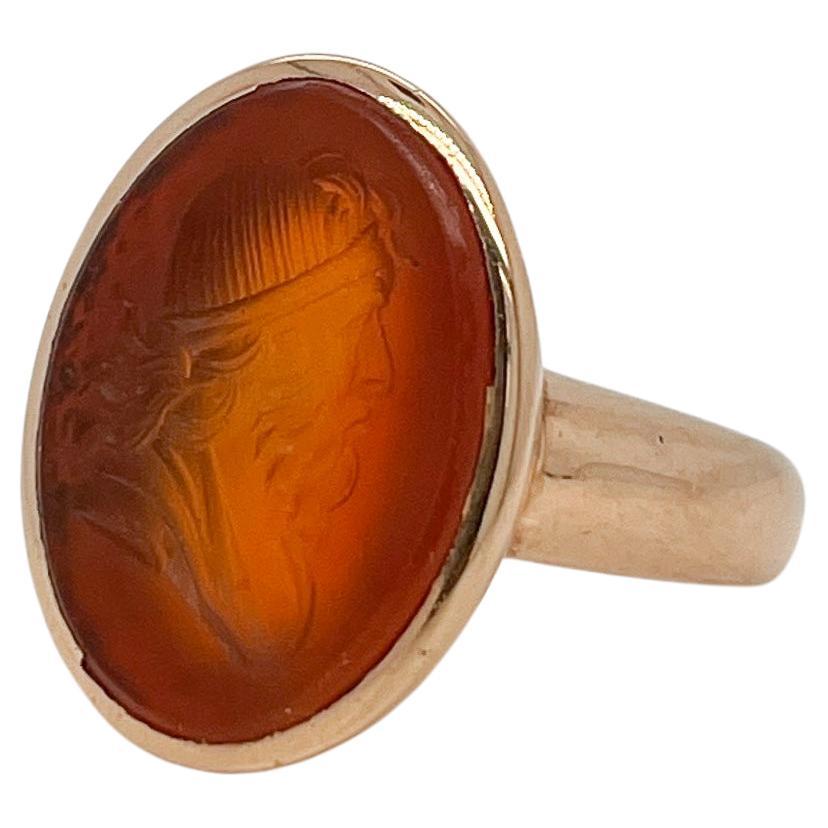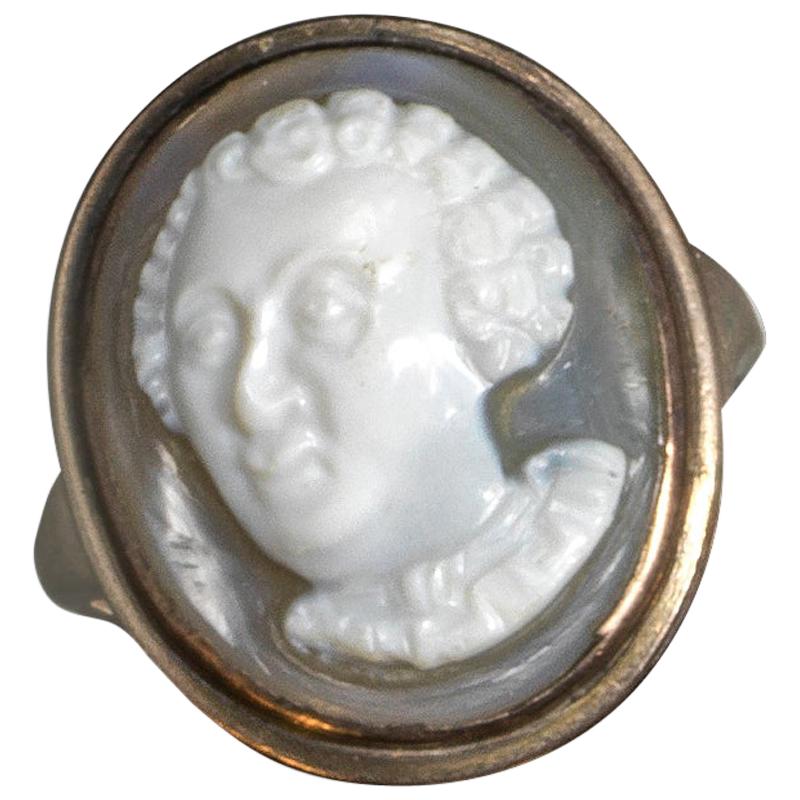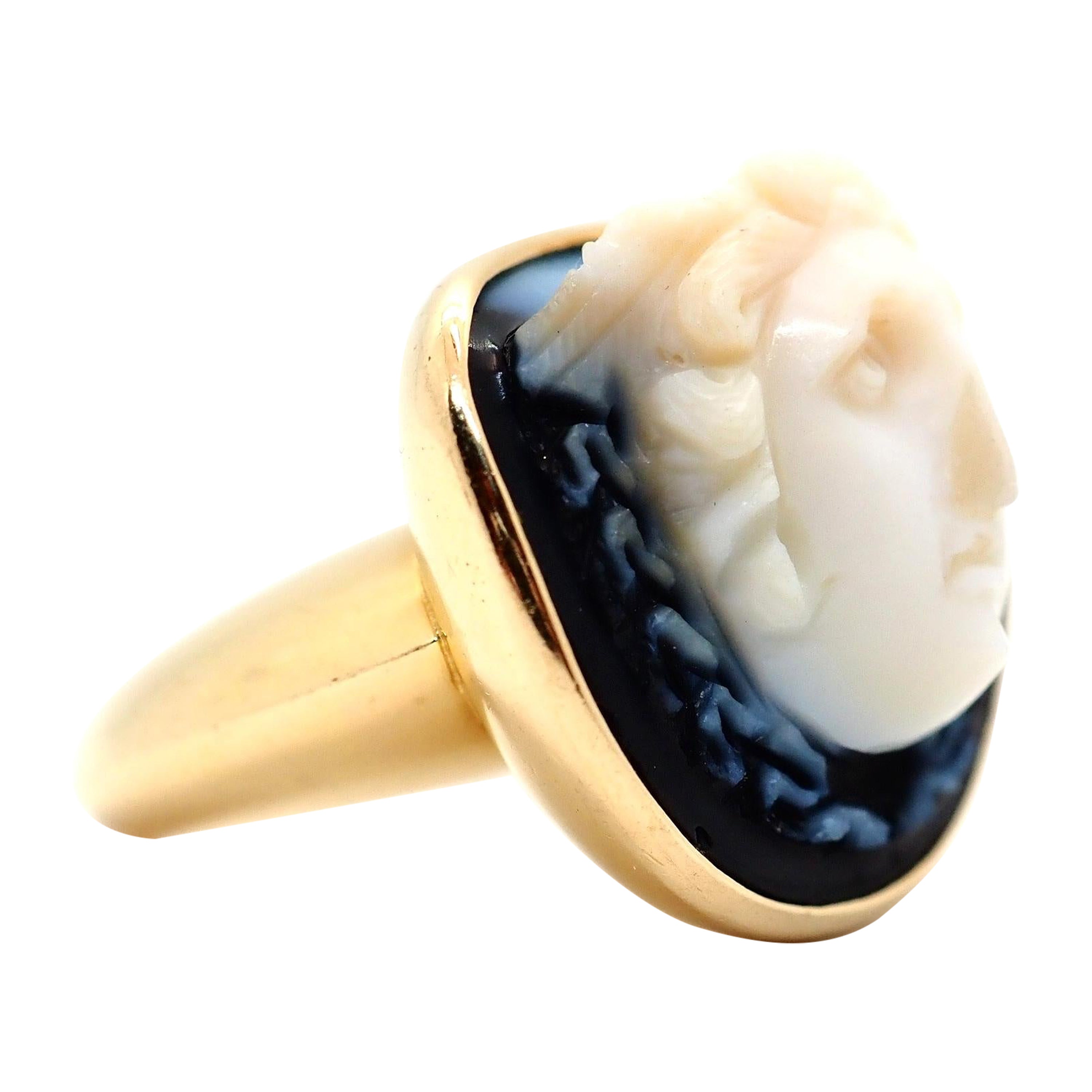Items Similar to Vintage 18K Gold French 1960’s Frosted Glass Cameo Ring Renaissance Revival
Video Loading
Want more images or videos?
Request additional images or videos from the seller
1 of 15
Vintage 18K Gold French 1960’s Frosted Glass Cameo Ring Renaissance Revival
About the Item
A superb and unusual glass cameo ring made in Paris, circa 1960. The ring is rather large in scale, crafted in 18K gold and weighing a seriously impressive 29 grams. In the centre rests a bright orange “pate de verre” (moulded glass paste) cameo with a frosted glass effect to the front and a faceted underside. The cameo depicts the bust of a woman in classical style wearing a wreath of flowers and grapes.
The ring head features an openwork gallery which takes the form of circles which are enamelled in black. There is a white and black enamelled floral motif on each shoulder with chased crosshatching in typical Renaissance style.
This impressive ring is particularly unusual due to the fact that incorporates a variety of revival styles into the design, for example the 17th century style shoulders with the Art Deco era frosted glass classical bust.
UK size Q, US size 8 1/2
29g, French hallmarked 18K gold
Cameo measures 32mm x 23mm, band measures 4mm wide at back
- Ring Size:8.5 US, Resizable
- Metal:
- Weight:29 g
- Style:
- Place of Origin:
- Period:
- Date of Manufacture:1960
- Condition:
- Seller Location:London, GB
- Reference Number:1stDibs: LU2845220502172
Resizing is available.
About the Seller
5.0
Vetted Seller
These experienced sellers undergo a comprehensive evaluation by our team of in-house experts.
Established in 2019
1stDibs seller since 2022
32 sales on 1stDibs
Typical response time: 11 hours
- ShippingRetrieving quote...Ships From: London, United Kingdom
- Return PolicyA return for this item may be initiated within 14 days of delivery.
More From This SellerView All
- Antique Italian 18th Century Georgian Gold Cameo Ring Bust of Medusa HardstoneLocated in London, GBA gorgeous 18th century Italian hardstone cameo ring. This beautiful four layered sardonyx cameo is carved from a single piece of agate with immense skill to reveal the bust of the G...Category
Antique Late 18th Century Italian Neoclassical Signet Rings
MaterialsAgate, Gold, 22k Gold
- Edwardian 18K Gold Royal Interest Cypher Monogram Enamelled Presentation RingLocated in London, GBA beautifully enamelled Royal monogram ‘cypher’ presentation ring of Prince Arthur William, Duke of Connaught and Strathern. It was made around 1905 and crafted in 18K gold. It would have started life as a royal presentation lapel pin and has since been converted into a ring. The cypher features crimson and ivory enamel and is placed below an intricate coronet with fleurs-de-lis and crosses pattée, the coronets used by children or grandchildren of the British sovereign...Category
Antique Early 1900s English Edwardian Signet Rings
Materials18k Gold, Enamel
- Antique Gold Cameo Ring Greek Theatre Mask Silenus Hardstone Intaglio SignetLocated in London, GBA very unusual antique gold ring set with a carved brown and white hardstone cameo depicting the theatrical comic mask of Silenus, the Greek mythological old rustic god of wine-making and drunkenness. The ring was made in the late 19th century and carries French control marks for 18K gold, whilst the cameo is probably Italian and made slightly earlier, circa 1800. Silenus was a companion to the wine god Dionysus, and suitably he was a notorious consumer of wine, usually drunk and supported by satyrs or carried by a donkey. Silenus was described as the oldest, wisest and most drunken of the followers of Dionysus, and was said to possess special knowledge and the power of prophecy when intoxicated. He presides over the other satyrs and is related to musical creativity, prophetic ecstasy, drunken joy and drunken dances. Silenus was usually depicted as a jovial old man, bald yet bearded, with a pot-belly, thick lips and snub-nose. The masks worn to play him in theatre really emphasised these features, as you can see with this cameo carving Theatre was a key part of ancient Greek culture. The theatrical masks worn by the actors, known as ‘prosopon’, served various purposes. They enabled individual actors to play multiple roles (or genders) in the same performance; the exaggerated expressions helped define the character being portrayed; they helped spectators in the back rows to tell the characters apart. This particular masked as mentioned before is a comedic Silenus, please see final photo for other examples of Silenus masks in museum collections. UK size N 1/2, US size 7 4.84g 18K gold French ‘tête...Category
Antique Early 19th Century Italian Georgian Signet Rings
MaterialsAgate, 18k Gold
- French Neo-Renaissance Intaglio Signet Ring Manner of Wièse & Froment-MeuriceLocated in London, GBA fantastic French 19th century Neorenaissance silver intaglio ring, in the manner of Jules Wièse and Froment-Meurice, circa 1840. The milky blue ...Category
Antique Mid-19th Century French Belle Époque Signet Rings
MaterialsChalcedony, Silver
- Antique Victorian Heavy 18K Gold Bloodstone Signet Ring Mens Coat of Arms c.1890Located in London, GBA superb and heavy solid 18K gold antique signet ring, made in 19th century Victorian England, circa 1890. The centrepiece of this substantial go...Category
Antique Late 19th Century English Victorian Signet Rings
Materials18k Gold
- Important Antique Finnish 18K Coat of Arms Klinckowström Intaglio Signet RingLocated in London, GBA superb, scarce Finnish antique 18K gold ring that was made in Helsinki in the year 1854. The oval carnelian coat of arms intaglio is set in a large intricate gold repoussé work mount featuring scrolled foliate motifs. Incredibly, thanks to a full set of Finnish hallmarks, as well as from the intaglio carving itself, we can identify who commissioned and wore this superb seal ring. The coat of arms engraved into the carnelian gemstone is that of the Klinckowström family, an old Prussian noble house whose members played prominent roles in the history of Prussia, Sweden, Finland and Austria. The family was granted nobility in Sweden in 1684 by King Charles XI, and then received the rank of baron in 1759 from King Adolf Frederick. The baronial branch was listed in the Finnish House of Nobility (Ritarihuone) from 1818 until the family line ended in Finland in 1883. This baronial element can also be seen in the engraved coat of arms from the specific type of coronet used, it is set with pearls and known as a ‘Friherrlig rangkrona’, the coronet for Baron. The hallmarks tell us that this ring was made in Helsinki in the year 1854. Accordingly, the ring must have been made for a Baron (male) of the Klinckowström family, present and active in Finland during the mid-19th century. After researching into the genealogial records, only one member of the family settled in Finland, which was Baron Otto Wilhelm Klinkowström (1778-1850), and this ring would have been commissioned by his son Baron Arthur Wilhelm Wilhelmsson Klinckowström, shortly after his father’s passing. The ring would have been made in used to seal deeds and important letters in wax regarding family affairs. Arthur had two sons. Emil and Alexander who carried on the baronial title until 1883, when the family line ended on the male side. Although the time period of this ring also matches up with his both his sons, according to heraldry records they both carried a slightly different coat of arms. Arthur, the owner of this ring enrolled in the House of Knights in Finland aged 17 and soon after received the Order of St. John of Jerusalem. He spent the remainder of his years in various senior military positions, such as Lieutenant Colonel of the Finnish Sharpshooter Battalion and Colonel of the Kremenchugska Hunter Regiment. He passed away in 1860, not long after his father, which may explain why this ring is in such excellent condition with minimal signs of usage. His father, Baron Otto Wilhelm Klinkowström (1778-1850) was a Swedish lieutenant general who later moved to Finland, where he immediately found favour with Czar Alexander I of Russia...Category
Antique 1850s Finnish Victorian Signet Rings
Materials18k Gold
You May Also Like
- Lalaounis 18K Gold & Amethyst Greek Revival Bull's Head RingBy Ilias LalaounisLocated in Philadelphia, PAA fine Greek Revival style ring. In 18 karat yellow gold and set with a small round amethyst. In the form of a stylized bull's head with granulation mounted on a tapered and twiste...Category
20th Century Greek Greek Revival Cocktail Rings
MaterialsAmethyst, 18k Gold
- Roman Emperor Augustus Georgian Period Sardonyx Cameo 18K Gold RingLocated in New York, NYSuperbly carved Georgian period sardonyx cameo signet ring depicting Roman Emperor Augustus in profile Late 18th/ Early 19th Century Condition: Ver...Category
Antique Late 18th Century European Classical Roman Signet Rings
Materials18k Gold, Yellow Gold
- Archeological Revival Roman Seal Ring 18k-20kLocated in Litchfield, CTCirca 1820 to 1830s, 18k-20k, possibly English. This beautiful Georgian ring is set with a fine late-Roman Empire seal (intaglio-cut garnet). Meticulously made in rich higher karat g...Category
Antique 1820s British Georgian Signet Rings
MaterialsGarnet, 18k Gold, Yellow Gold
- Antique Etruscan Revival 18K Gold & Carnelian Carved Intaglio Signet RingLocated in Philadelphia, PAA fine Etruscan Revival gold & carnelian signet ring. With a bezel-set cabochon carnelian that has an intaglio carved image of an Ancient Greek or Roman scholar or philosopher. The...Category
Early 20th Century Unknown Etruscan Revival Signet Rings
MaterialsCarnelian, 18k Gold
- Late Renaissance Agate Cameo Ring Alessandro de' MediciLocated in Firenze, ITCameo depicting Alessandro de' Medici, known as (IL Moro or 'The Moor'), c. 16th - 17th century, in later gold ring mount, cameo 2.0cm high, ring size 7Category
Antique 16th Century Italian Renaissance Signet Rings
MaterialsAgate, Gold
- Rare Vintage Cameo Ring 18 Karat Yellow Gold Antique JewelleryLocated in Geneva, CHRare Exclusive Vintage Cameo Ring in 18k Yellow Gold ✨ Step back into a bygone era with this captivating 18k yellow gold ring, featuring an exquisite cameo...Category
20th Century European Art Deco Signet Rings
Materials18k Gold, Yellow Gold
Recently Viewed
View AllMore Ways To Browse
14k Gold Carnelian
Carnelian Display
Gents Diamond Signet Ring
Early 20th Century Canadian Enamel Brooches
Mens Solid Gold Garnet Ring
Venus Intaglio
14 Karat Yellow Gold Shield Rings
Prussia Jewelry
Custom Signet Ring
Skull Medieval Ring
Gold Ring With A Silver Coin
Unicorns Scottish
Ancient Silver Signet Ring
Martyn Lawrence Bullard Jewelry
Moon Signet Ring
Sardonyx Signet Ring
Alexander The Great Coins As Rings
Vintage Signet Ring E

